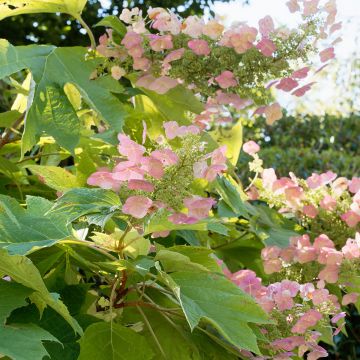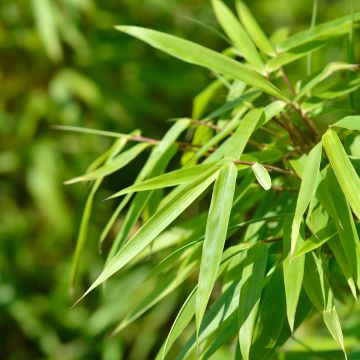

Exochorda racemosa Snow Mountain - Pearlbush
Exochorda racemosa Snow Mountain - Pearlbush
Exochorda racemosa Snow Mountain
Pearlbush, Common Pearlbush
Why not try an alternative variety in stock?
View all →This plant carries a 24 months recovery warranty
More information
We guarantee the quality of our plants for a full growing cycle, and will replace at our expense any plant that fails to recover under normal climatic and planting conditions.
From €5.90 for pickup delivery and €6.90 for home delivery
Express home delivery from €8.90.
Does this plant fit my garden?
Set up your Plantfit profile →
Description
Exochorda racemosa 'Snow Mountain' is a variety with splendid spring flowering. The entire bush resembles a snow-capped peak, as its dome of foliage is then covered with white flowers. The spectacle begins even earlier, as the swollen white flower buds along the branches resemble strings of precious pearls. Requiring almost no maintenance, this compact and hardy bush thrives in most moist and well-drained soils.
Exochorda is a member of the vast family of Rosaceae, which includes both wild plants from the countryside and ornamental plants such as Sorbaria or Hawthorn (Crataegus), as well as most temperate fruit trees (Apple, Peach...). The Exochorda genus is relatively recent, created in the mid-19th century by the English botanist Lindley, and consists of only four to ten species, and even just one according to some classifications, Exochorda racemosa. This bush was discovered in northern China by the great botanist Robert Fortune and shipped in 1849 to the Standish and Noble nurseries in Bagshot (near London), where it first bloomed in Europe in 1854, causing great admiration. It is also known as Clustered Exochorda. The wild plant forms a bush 3 m tall that grows on shaded slopes at altitudes of 200 to 500 m, in China, Korea, Manchuria, and Central Asia, which explains its cold resistance.
'Snow Mountain' is a selection by Herman Geers from the Spring Meadow nursery, which spans nearly 14 hectares of greenhouses in Michigan (United States). This recent variety (2013) is particularly interesting for its compactness and denser habit compared to the botanical type species. This bush reaches a height of 1.60 to less than 2 m at maturity forming a superb dome without needing pruning. It can therefore easily find a place in most gardens, even the smallest. Its growth is relatively moderate, approximately 15 to 30 cm per year. The branches bear small, 4 to 6 cm long, elliptical to elongated, medium green leaves, borne on short petioles. The first flower buds appear around mid-February and gradually swell, forming what looks like strings of pearls along the branches. Their pearly white colour gives the bush its common name of Pearl Bush. From April, depending on the climate and region, and more generally in May, the immaculate white flowers open and cover the foliage. Measuring 4 cm in diameter, they are grouped in racemes (clusters) of 6 to 10, attracting pollinating insects. The dome of foliage completely disappears under the blanket of flowers, which gives this variety its name ("snow mountain"). In autumn, the deciduous foliage falls to the ground, preparing the bush for potentially harsh winters that it will endure without harm down to -25°C or -30°C.
Exochorda racemosa 'Snow Mountain' is a spring splendour that can be planted in an informal hedge, within a varied border, or even in a large container. Few plants can rival the exuberance of its flowering, so choose to accompany it with other generous bushes. Chinese Azalea 'Demoiselles de Boutiguery Aurora' will hold its own with its star-shaped flowers of raspberry pink tinged with apricot, creating a wonderful colour contrast. Also play with the timing of flowering by including Forsythias, which are also champions of floriferousness that are covered from head to toe with small bright yellow flowers early in the season. And for summer, nothing beats Hydrangeas, which will reward you with their often large and sometimes even giant inflorescences like those of Hydrangea paniculata 'Hercules', which, like your Exochorda, will adapt to most soils.
Report an error about the product description
Plant habit
Flowering
Foliage
Botanical data
Exochorda
racemosa
Snow Mountain
Rosaceae
Pearlbush, Common Pearlbush
Cultivar or hybrid
Other Exochorda
Planting and care
Plant Exochorda racemosa 'Snow Mountain' in full sun, not scorching, or under light shade, in fertile, damp, yet loose and well-drained soil. Any good garden soil that is well-worked, but not too chalky, will suffice. The ideal is a neutral to slightly acidic soil, this bush accepts a pH range from 5.5 to 7.5, which covers most situations. Plant it in deep soil during autumn for flowering in the following May. A light pruning after flowering is recommended to remove the spent branches and to tidy up the foliage.
Pruning for this variety 'Snow Mountain' is kept to a minimum. However, you can cut back the oldest branches (over three years old) by one third, every two to three years, after flowering, while ensuring good air circulation in the centre of the bush. This will encourage the formation of young shoots and prevent the bush from becoming bare at the base.
Planting period
Intended location
Care
This item has not been reviewed yet - be the first to leave a review about it.
Hedge shrubs
Haven't found what you were looking for?
Hardiness is the lowest winter temperature a plant can endure without suffering serious damage or even dying. However, hardiness is affected by location (a sheltered area, such as a patio), protection (winter cover) and soil type (hardiness is improved by well-drained soil).

Photo Sharing Terms & Conditions
In order to encourage gardeners to interact and share their experiences, Promesse de fleurs offers various media enabling content to be uploaded onto its Site - in particular via the ‘Photo sharing’ module.
The User agrees to refrain from:
- Posting any content that is illegal, prejudicial, insulting, racist, inciteful to hatred, revisionist, contrary to public decency, that infringes on privacy or on the privacy rights of third parties, in particular the publicity rights of persons and goods, intellectual property rights, or the right to privacy.
- Submitting content on behalf of a third party;
- Impersonate the identity of a third party and/or publish any personal information about a third party;
In general, the User undertakes to refrain from any unethical behaviour.
All Content (in particular text, comments, files, images, photos, videos, creative works, etc.), which may be subject to property or intellectual property rights, image or other private rights, shall remain the property of the User, subject to the limited rights granted by the terms of the licence granted by Promesse de fleurs as stated below. Users are at liberty to publish or not to publish such Content on the Site, notably via the ‘Photo Sharing’ facility, and accept that this Content shall be made public and freely accessible, notably on the Internet.
Users further acknowledge, undertake to have ,and guarantee that they hold all necessary rights and permissions to publish such material on the Site, in particular with regard to the legislation in force pertaining to any privacy, property, intellectual property, image, or contractual rights, or rights of any other nature. By publishing such Content on the Site, Users acknowledge accepting full liability as publishers of the Content within the meaning of the law, and grant Promesse de fleurs, free of charge, an inclusive, worldwide licence for the said Content for the entire duration of its publication, including all reproduction, representation, up/downloading, displaying, performing, transmission, and storage rights.
Users also grant permission for their name to be linked to the Content and accept that this link may not always be made available.
By engaging in posting material, Users consent to their Content becoming automatically accessible on the Internet, in particular on other sites and/or blogs and/or web pages of the Promesse de fleurs site, including in particular social pages and the Promesse de fleurs catalogue.
Users may secure the removal of entrusted content free of charge by issuing a simple request via our contact form.
The flowering period indicated on our website applies to countries and regions located in USDA zone 8 (France, the United Kingdom, Ireland, the Netherlands, etc.)
It will vary according to where you live:
- In zones 9 to 10 (Italy, Spain, Greece, etc.), flowering will occur about 2 to 4 weeks earlier.
- In zones 6 to 7 (Germany, Poland, Slovenia, and lower mountainous regions), flowering will be delayed by 2 to 3 weeks.
- In zone 5 (Central Europe, Scandinavia), blooming will be delayed by 3 to 5 weeks.
In temperate climates, pruning of spring-flowering shrubs (forsythia, spireas, etc.) should be done just after flowering.
Pruning of summer-flowering shrubs (Indian Lilac, Perovskia, etc.) can be done in winter or spring.
In cold regions as well as with frost-sensitive plants, avoid pruning too early when severe frosts may still occur.
The planting period indicated on our website applies to countries and regions located in USDA zone 8 (France, United Kingdom, Ireland, Netherlands).
It will vary according to where you live:
- In Mediterranean zones (Marseille, Madrid, Milan, etc.), autumn and winter are the best planting periods.
- In continental zones (Strasbourg, Munich, Vienna, etc.), delay planting by 2 to 3 weeks in spring and bring it forward by 2 to 4 weeks in autumn.
- In mountainous regions (the Alps, Pyrenees, Carpathians, etc.), it is best to plant in late spring (May-June) or late summer (August-September).
The harvesting period indicated on our website applies to countries and regions in USDA zone 8 (France, England, Ireland, the Netherlands).
In colder areas (Scandinavia, Poland, Austria...) fruit and vegetable harvests are likely to be delayed by 3-4 weeks.
In warmer areas (Italy, Spain, Greece, etc.), harvesting will probably take place earlier, depending on weather conditions.
The sowing periods indicated on our website apply to countries and regions within USDA Zone 8 (France, UK, Ireland, Netherlands).
In colder areas (Scandinavia, Poland, Austria...), delay any outdoor sowing by 3-4 weeks, or sow under glass.
In warmer climes (Italy, Spain, Greece, etc.), bring outdoor sowing forward by a few weeks.

















































